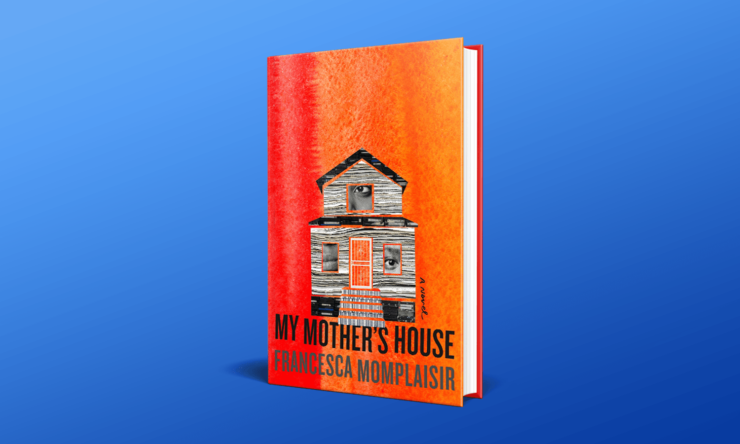“The House floated in and out of consciousness, waiting to die. It would no longer have to stomach wickedness, deviance, and injustice. It looked forward to Its demolition that would level and free It at long last.”
Francesca Momplaisir’s novel My Mother’s House tells the tale of a sentient home that burns itself to the ground in rage and despair at housing a terrible and abusive man. The dark and unsettling story follows Lucien, who flees his home country of Haiti with his wife, Marie-Ange, and their three children to move to New York City’s South Ozone Park and seek a fresh start. The family then buys a run-down house that they name “La Kay,” or “My Mother’s house,” which becomes a place for fellow Haitian immigrants to find peace, food, and legal assistance. What the family doesn’t know, however, is that all the while the house is watching and passing judgment on all of its inhabitants and is particularly upset at Lucien’s cruel behavior. But after La Kay burns itself to the ground, Lucien’s true evil nature is revealed.
Momplaisir’s story is a challenging and complex one, but ultimately a success. Through an unflinching look at Lucien’s violence and emotional damage towards the other characters in the novel, the book does an incredible job at portraying the generational traumas that immigration and poverty can have on a family. My Mother’s House does not shy away from other sensitive and rarely heard narratives such as societal indifference to Black women’s pain and the ways that women are marginalized in social unrest and migration, and the responsibility of women and matriarchs to protect against violence that they are also subject to.
The novel tells the family’s story from multiple perspectives. Each character has several chapters devoted to understanding their role in the narrative, and La Kay’s perspective is also heard in the book. This narrative technique allows the reader to understand the full scope of horrors happening within the house’s walls and within each character’s mind. In chapters told by the children or Marie-Ange, we see first hand the impact that psychological abuse at the hand of a family member has on these women. Interestingly, the reader walks away with a much more intimate understanding of Lucien’s trauma than we do any of the women, as his chapters give us insight into his sad and tortured view on his family and life. By far, one of the author’s greatest strengths was her ability to weave the house into the narrative as not only an object, but a character, as the La Kay chapters reveal the house’s devastation at the horrors happening within Its walls, and Its frustration at not being able to stop it.
My Mother’s House is impossible to pigeonhole; though it’s marketed as a literary thriller, elements of the novel also qualify as horror, realistic fiction, and magical realism. The underlying narrative of the story which follows an immigrant family struggling to make lives for themselves embodies a grim realism, though the drama between family members also gives the book a touch of the supernatural. The tonal shifts between the chapters allow for some dark humor to live within the narrative, but the overall premise of a sentient house also suggests elements of magical realism. The heavy plot of the book, as well as the majority of the interactions between Lucien and his family, are inundated with thriller and horror. Many authors would not be able to pull off a novel that encapsulates so many genres and styles, but Momplaisir’s beautiful, poetic prose and impeccable narrative pacing melds each of these literary elements perfectly to create a satisfying, slow burning narrative and an unforgettable read that caters to a variety of interests.
Though thriller drives the plot forward, at times, the horrors of the book become almost too much to bear. Certain scenes in the novel are simply not for the faint of heart—torture, immense cruelty, violence, and a particular moment involving the abuse of a cat come to mind as making my stomach turn. Momplaisar’s prose, which effortlessly evokes strong emotions and creates vivid imagery in very few words, allows the reader to viscerally understand and experience each victim’s harm. Like La Kay, the reader is forced to watch the unspeakable horrors occurring in the house and desperately wish there was a way we could make them end.
My Mother’s House tackles some of our most pressing societal issues, including gentrification, racial injustice, and the psychological harm of migration, with rarely encountered grace and an unflinching eye. At its heart, the story forcefully explores how the great “American Dream” is only afforded to the rare individual provided a certain level of privilege.
Buy My Mother’s House From Underground Books
Or Explore Other Great Indie Bookstores Here!
Originally published in May 2020
My Mother’s House is available from Knopf.
Mary is a freelance writer covering culture, identity, sexual politics, and wellness. Her work has been featured in The Guardian, The Nation, Glamour, Teen Vogue, Bitch Media, Vice, Nylon, Allure, and other similar outlets. When she is not writing she can be found scheming, watching cartoons, or sending unnecessarily long emails. To see more of Mary’s work and adventures, follow her on Twitter.










